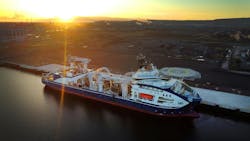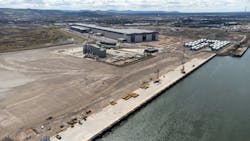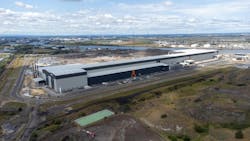Op-ed: Freeport status enables quick infrastructure development for UK’s offshore wind sector
Key Highlights
- Teesworks covers 4,500 acres and is central to the UK's largest Freeport, supporting offshore wind with significant infrastructure and job creation.
- Freeport incentives such as tax reliefs, duty deferrals and customs zones reduce costs and attract international investment, boosting offshore wind supply chain capacity.
- Key infrastructure projects like Steel River Quay and the world's largest monopile factory at SeAH Wind exemplify strategic investments accelerating offshore wind deployment.
By Matt Johnson, Teesworks
As the UK strives toward its net zero 2030 goals, the offshore wind sector is entering a new phase—one that demands a stronger foundation of infrastructure, supply chain capacity and skilled talent. Freeport status is helping to meet these needs by enabling faster development of critical infrastructure.
Covering 4,500 acres, Teesworks sits at the heart of the UK’s largest Freeport and industrial redevelopment zone in Tees Valley on the northeast coast of England. The region has long been one of the UK’s most globally connected industrial economies, with about 70% of businesses internationally owned. The redevelopment of Teesworks has already created more than 2,725 long-term jobs, and its location on the North Sea coast provides direct access to some of the world’s most active offshore wind development zones, including Dogger Bank, which is set to become the world’s largest offshore wind farm upon completion in 2027.
Benefits of Freeport status
Freeport status plays a critical role in accelerating offshore wind delivery by offering targeted benefits for manufacturers and logistics operators. These include 0% Employer National Insurance contributions for up to three years per employee on earnings up to £25,000 (US$33,622) per annum; up to 100% relief from business rates on certain business premises for a maximum of five years; enhanced tax relief for companies investing in qualifying new plant, machinery assets and buildings; and duty deferral while goods remain on site within designated customs zones. These incentives reduce upfront costs and financial risk, providing certainty and encouraging companies to invest in the development of offshore wind projects.
In addition, companies acquiring or leasing land within a designated Freeport tax site can claim full relief from Stamp Duty Land Tax on qualifying transactions, provided the land or buildings are used for approved commercial purposes. This exemption, available until September 2031, further reduces the cost of establishing or expanding operations and strengthens the financial case for investment within Freeport sites like Teesworks.
Importantly, the establishment of customs zones within Freeports strengthens international partnerships and export opportunities. By allowing international partners to bring goods into the Freeport without immediately paying tariffs, operational costs are reduced, cash flow is improved and global companies are incentivized to collaborate with UK manufacturers or logistics operators. This arrangement encourages inward investment and attracts long-term international partnerships and exports.
At Teesworks, this has enabled development of key infrastructure and attracted global supply chain players looking to scale up quickly, such as SeAH Wind, Ørsted and Cadeler. The former Redcar steelworks site, which ceased operations in 2015 following the liquidation of SSI UK, has undergone a significant transformation into a global hub for offshore wind manufacturing and logistics. This redevelopment aims to support the UK’s transition to clean energy and stimulate regional economic growth by combining large-scale infrastructure with Freeport incentives and a growing pipeline of skilled workers.
Environmental considerations have been a critical component of the redevelopment project, involving a robust materials and waste management strategy, which diverted waste from landfill to maximize the reuse of earthworks materials, ensure environmental compliance and enhance project sustainability.
Differentiating Teesworks from other UK and European offshore wind hubs is its integration of large-scale offshore wind manufacturing with deepwater loading facilities, particularly the SeAH Wind monopile manufacturing facility and Steel River Quay. This co-location reduces the need for component transport between sites, streamlines logistics and accelerates deployment timelines.
Combined with Freeport incentives, this integrated approach lowers operational costs compared with other hubs where manufacturing and port handling are separated.
Investment in infrastructure
A flagship example of investment into offshore wind infrastructure is the £114 million (US$154 million) Steel River Quay, which completed in spring 2024. This 450-m heavy-lift quay is purpose-built for offshore wind, featuring a 90-m-wide berth pocket, an operational depth of 13.6 m, a 2-m-thick rock blanket base for jackup and vessel stability and a heavy load pad capable of supporting 30 tonnes per square metre.
The quay welcomed its first operational ship, Prysmian’s Leonardo Da Vinci, in late 2024, marking the start of regular activity with up to 140 vessels expected annually.
Its first major leaseholder is Ørsted, which has signed an initial agreement for 140,000 sq m of space with potential expansion to 300,000 sq m, to facilitate monopile marshalling and storage, component pre-assembly and wind turbine installation vessel loading for the development of its 2.9-GW Hornsea 3 offshore wind farm.
Just minutes from Steel River Quay is another key component of the offshore wind supply chain, SeAH Wind’s XXL monopile manufacturing facility, costing £950 million (US$1.2 billion) and marked the world’s largest. Construction of the factory concluded earlier this year, and it has now begun production on its inaugural contract to supply monopiles for Hornsea 3. Covering more than 1.13 million sq ft, the factory expects to produce over 150 monopiles a year, each up to 120 m long and 3,000 tonnes in weight.
The proximity of these assets, combined with deepwater port access, illustrates how Freeport status and strategic planning is accelerating offshore wind supply chain readiness in the UK.
Investment in the workforce
Supporting the energy transition goes beyond infrastructure, it requires a skilled, future-proofed workforce. Teesworks Skills Academy, developed in partnership with the Tees Valley Combined Authority, is a central hub for specialist training related to Teesworks’ operations and has access to more than 300 industry-accredited courses.
As part of its training programs, the academy works closely with local colleges to support pathways into employment. With a database of more than 4,000 individuals, the academy matches job seekers in Teesside with opportunities created by the Teesworks site, both directly and via the wider supply chain.
One initiative is the 24-week welding bootcamp, which is delivered in partnership with Nordic Engineering. From more than 700 applicants, 24 Teesside residents were selected and trained in advanced MMA and MIG welding. Since completing the training course, all trainees have now secured full-time employment at the SeAH Wind monopile manufacturing facility.
“Success for Teesworks isn’t just about the number of jobs delivered, it’s about building confidence and securing futures. It’s about a young person in Teesside seeing a clear pathway into engineering. It’s about someone previously out of work finding a route back into employment. Ultimately, it’s about creating a self-sustaining workforce that will power the offshore wind industry for decades to come.”
—Neil Young, Teesside Freeport Skills & Workforce Development Manager
Freeport status has enabled rapid infrastructure delivery for offshore wind in the UK—a capability that is particularly valuable at a time when the sector faces rising costs, supply chain pressures and increasing international competition. The ability to accelerate delivery of critical assets while lowering investment risk makes Freeports an important tool in stabilizing and strengthening the UK’s offshore wind pipeline.
At Teesworks, these advantages have supported the rapid development of major assets such as Steel River Quay and the SeAH Wind monopile factory, while also underpinning investment in workforce training. Taken together, this demonstrates how Freeport policy can accelerate the readiness of the UK supply chain while ensuring that the sector can withstand uncertainty and continue progressing toward net zero targets.
About the Author

Matt Johnson
Matt Johnson is a director at Teesworks, the UK’s largest Freeport and industrial zone located in the Tees Valley. He oversees major development projects that are central to supporting the offshore energy sector, from building new port infrastructure to enabling supply chain growth. He plays a key role in the transformation of one of Europe’s largest brownfield sites and secures investment in key industries, such as clean energy, engineering and advanced manufacturing, helping to drive the UK’s net zero ambitions.


